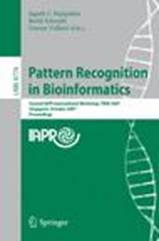|
The second IAPR International Workshop on Pattern Recognition in Bioinformatics (PRIB 2007) was organized by the School of Computer Engineering and BioInformatics Research Centre of Nanyang Technological University, Singapore.
The PRIB workshop/conference series are aimed at bringing together researchers, practitioners, and students from around the world to discuss applications of pattern recognition methods in bioinformatics to solve problems in life sciences. This is a major event of IAPR-TC 20 Pattern Recognition for Bioinformatics and provides a meeting venue for TC-20 members.
Bioinformatics is the marriage between computer science and biological sciences and aims at the discovery of new knowledge from life sciences data. The focus of TC-20 is to bring together pattern recognition modelers and life scientists to solve problems in bioinformatics. Over the past decade or so, there has been an increased interest in bioinformatics as computational experiments have led to a reduction in tedious and costly wet-lab experiments.
The opening address was given by Prof Bertil Anderson, Provost, Nanyang Technological University, Singapore. As Prof Anderson, one time chair of the committee for the Nobel Prize for biochemistry, pointed out, “It was only a decade or so ago that the idea that one could have life scientists and informatics researchers working together at the intersection of these disciplines was very unusual and experimental. Now, such is the dynamism and pace of change in the life sciences that bioinformatics has become an established and accepted discipline in its own right”
The workshop featured four keynotes: Prof. Nikhil Pal, Prof. Raj Acharya, Dr. Gary Fogel, and Dr. Glenn Tesler.
There were two parallel sessions of oral presentations and one poster session on each day of the workshop. Pattern recognition techniques that were discussed include: statistical, syntactic and structural approaches, neural networks, fuzzy techniques, genetic algorithms, Bayesian models and networks, data mining techniques, and their hybrids. The presentations represented the following applications of bioinformatics: • bio-sequence analysis • gene and protein expression analysis
The papers presented orally at the workshop were published as a volume in the Lecture Notes in Bioinformatics by Springer and Supplementary Proceedings included the papers presented as posters. A Special Issue on ‘Pattern discovery from bioinformatics data’ of IEEE Engineering in Medicine and Biology Magazine, including selected papers presented at the workshop will appear in 2008.
The Best Paper Award and the Best Student Paper Award were sponsored by IAPR. In addition, five student Travel Awards and twenty Student Awards were given best on the merits of the papers presented at PRIB 2007. |
|
Workshop Report: PRIB 2007 |



|
Proceedings of PRIB2007 are available in the |


|
Professor Bertil Anderson giving the opening address. |

|
Mr. Anunchai Assawamakin receiving the IAPR Best Student Paper Award from General Chair Professor Jagath Rajapakse |

|
IAPR Best Paper Awards
IAPR Best Paper Award Tim Hohm, Eckart Zitzler, “Multicellular Pattern Formation: Parameter Estimation for ODE based Gene Regulatory Networks”, ETH Zurich
IAPR Best Student Paper Award Anunchai Assawamakin, Nachol Chaiyaratana, Saravudh Sinsomros, Prakarnkiat Youngkong, “Variable-Length Haplotype Construction for Gene-Gene Interaction Studies”, Mahidol University, Thailand |
|
Workshop Summary Statistics
Total Number of Registrants = 97 IAPR member registrants = 11 Countries participated = 21 Number of papers received = 134 Published in the proceedings = 38 Oral presentations = 48 Poster presentations = 30 |
|
Report prepared by Jagath C. Rajapakse |